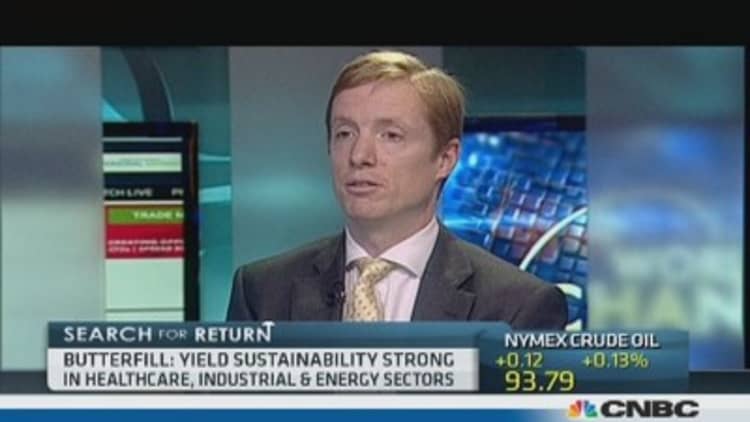
They deliver downside protection. They post stable returns. And they generate predictable income. What's not to like about dividend-paying stocks?
Indeed, equities that pay out a portion of their profits to shareholders have attained rock star status among income investors who fled the bond market when Treasury yields hit rock bottom in 2012. And they did not disappoint.
The S&P 500 Dividend Aristocrats index, which includes companies that have increased their dividend for at least the last 25 years, posted a 32.2 percent total return in 2013, up from nearly 17 percent the year before. By comparison, the S&P 500 Index was up 32.4 percent in 2013 and 16 percent in 2012, according to S&P Dow Jones Indices.
With S&P 500 dividends expected to increase 8.9 percent to $352 billion in 2014, according to Markit, the love affair is likely to continue.
"There is a secular change taking place in that baby boomers who are retiring know they still need to own equities for capital appreciation," said Josh Peters, equities strategist for Morningstar. "Dividend-paying stocks become very important not just because they generate income but because most are defensive plays, such as consumer staples, utilities and telecommunications, so there's less risk to earnings in an economic slowdown."
Like all things rooted in Wall Street, however, risk factors abound.
(Read more: Dividend party just getting started on Wall Street)
Be wary of yields
Investors who hope to ride the dividend rally should steer clear, in particular, of high-yielding stocks that are sensitive to rising interest rates, like REITs, said Tom Anderson, chief investment officer for Boston Private Bank & Trust Co.
Many REITs are distributing dividends of 5 percent or better, well above the benchmark 10-year Treasury yield, which doubled late last year to 3 percent. American Realty Capital Properties (ARCP), which owns and operates commercial real estate, offers a 7.25 percent yield. But the majority of REITs also slashed their dividend during the financial crisis in 2008 and 2009, leaving yield-hungry investors to lick their wounds. REIT yields have since come back, with the FTSE NAREIT U.S. All REIT index yielding an average dividend of 4.2 percent.
Income-producing equities in general tend to fall out of favor when rates tick up, and many economists predict higher rates ahead as the Federal Reserve scales back its economic stimulus program. "As interest rates rise, bond yields will reach a point at which investors find them attractive again," said Anderson, noting bonds will eventually reclaim some of the dollars that are currently invested in fixed-income alternatives, like dividend stocks.
Investors who reach for yield without considering the underlying strength of the companies they own may get burned as the dividend rally rages on, said Peters.
(Read more: Earnings pose the next hurdle for stocks)
Dividend growers and initiators in the S&P 500 produced a total annual return of 10.1 percent between 1972 and 2013, compared with 9.3 percent for all dividend-paying stocks and 7.6 percent for the S&P 500 Index.Ned Davis Research
Tech's upside potential
Of late, technology stocks have been the most generous to shareholders. Microsoft (Nasdaq: MSFT), for example, paid out 3.15 percent last year, while Intel (Nasdaq: INTC) offered a 3.6 percent yield. According to Morningstar, in fact, the 65 tech stocks included in the S&P 500 have nearly doubled their annualized dividend payout over the last two years—to $52 billion in 2013 from $28 billion in 2011. (Due to the size of the sector-by-market capitalization, however, its average yield is still 1.6 percent, below the average S&P 500 dividend yield of roughly 2 percent.)
"We've seen the biggest growth of dividend income in the tech sector, but it's hard to take advantage of that trend," said Peters. "You can't count on the stability of their business models the way you can a General Mills (NYSE: GIS). Even though their dividends can be a lot more generous, it's difficult to make the case that they also have those defensive qualities that people look for in retirement portfolios."
High-yielding stocks also tend to reward for lack of upside potential, and many have become overvalued since the financial crisis began, pushing P/E ratios into the danger zone, said Richard Sipley, senior portfolio manager for Boston Private Bank & Trust Co. Utilities, for example, are currently trading at 17 times earnings despite regulatory pressure and a flattened demand.
"That's at the high end of the historical range for utilities," said Sipley, noting his firm is underweight on the sector. "A lot of people are just seeing the yield, but you have to look at their underlying business and what's driving cash flow," he added.
(Read more: Growth test: Cramer's exclusive 10-point system)
The long-term payoff
Despite the landmines, however, the benefits of owning income equities over the long haul far exceed any short-term risks—if you stick with companies that consistently raise their dividend, said Bill Staton, a chartered financial advisor with Staton Financial Advisors in Charlotte, N.C., and author of Double Your Money in America's Finest Companies: The Unbeatable Power of Rising Dividends.
Dividend growers, like Boeing (NYSE: BA), Johnson & Johnson (NYSE: JNJ) and Pfizer (NYSE: PFE), he said, have a proven business model and a disciplined management team, which leads to higher returns over time.
Indeed, Ned Davis Research reports that dividend growers and initiators in the S&P 500 produced a total annual return of 10.1 percent between 1972 and 2013, compared with 9.3 percent for all dividend-paying stocks and 7.6 percent for the S&P 500 Index.
"A good rule of thumb is to look for companies that have paid a higher cash dividend for a minimum of 10 consecutive years," said Staton. "If a company keeps its dividend flat or, worse, cuts it, I tell clients to immediately sell the stock."
Investors can pay a professional to select their dividend stocks for them, using an actively managed mutual fund or Exchange Traded Fund that seeks to deliver income by investing in dividend stocks.
(Read more: The new world of stock investing)
Keep it simple
PowerShares Dividend Achievers (PFM), up nearly 20 percent for the 12-month period ending Jan. 8, 2014, is among them, along with the newly launched ProShares' S&P 500 Aristocrats ETF (NOBL). Fidelity Dividend Growth (FDGFX) fund is up 27 percent for the same time period.
Check the fund's top 10 holdings to be sure it isn't overly concentrated on any one sector of the market, and look for funds that keep their expense ratio well below 1 percent, said Sipley.
Staton agreed, adding that with funds that have a higher expense ratio, you're better off picking a diversified basket of dividend stocks on your own, using the S&P 500 Dividend Aristocrat list as your guide.
Focus on dividend growers that yield between 3 percent and 7 percent per year, said Peters. "That's the sweet spot," he said, noting anything less and the income isn't reason enough to own the stock. Anything more, and the company's ability to continue raising its dividend may be compromised.
"Keep it simple," said Peters. "Avoid the really high-yielding stocks, like mortgage REITs and oil production master limited partnerships. They don't pass the simplicity test, and if they fail to issue a dividend in the future, you can expect the stock price to get hammered."
Above all else, he added, investors should remember to maintain an age-appropriate allocation to fixed income. Despite their annual payout, dividend stocks are not a proxy for bonds. They are equities that post gains and losses like any other publicly traded stock.
"Dividend-paying stocks are more conservative and less volatile in general," said Peters. "They do have some hybrid qualities, and they share the best of both worlds in giving investors the consistent income they'd expect from bonds, along with capital appreciation to offset inflation. But they are still stocks."
—By Shelly K. Schwartz, Special to CNBC.com



